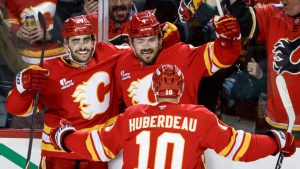The Colorado Avalanche locked up their biggest star on Tuesday, signing Nathan MacKinnon to an eight-year extension worth $100.8 million.
The deal, which carries a $12.6-million cap hit once it kicks in ahead of the 2023-24 season, will make MacKinnon the highest-paid player in the NHL – just edging the $12.5-million average annual value on the deal Connor McDavid signed with the Edmonton Oilers in July 2017. That cap hit is projected to account for 15.27 per cent of Colorado's cap space.
There are, of course, multiple ways to define “highest-paid” – there is the obvious AAV/cap hit, but that doesn’t always match a player’s total salary. This season, for example, McDavid has the largest cap hit at $12.5 million but will earn $12 million in salary on his deal. Per CapFriendly, the highest-paid player in 2022-23 based on total salary is Dallas Stars forward Tyler Seguin at $13 million, followed by New York Rangers star Artemi Panarin ($12.5 million). Five players – Panthers' Aleksander Barkov and Sergei Bobrovsky, McDavid and fellow Oiler Darnell Nurse, and Sharks defenceman Erik Karlsson – will bring in $12 million in salary this upcoming season.
Any way you look at it, though, MacKinnon will be the league’s highest-paid player both in cap hit and salary – he’s set to earn a whopping $16.5 million in salary once his new deal comes into effect next July. (Rounding out the top five highest salaries next season? Dougie Hamilton at $12.6 million, followed by Seth Jones, Kirill Kaprizov and Alex Ovechkin at $12.5 million. Alex Pietrangelo is sixth at $12.3 million.)
Fresh off winning a Stanley Cup and with Colorado’s core locked in and ready for more, it was really only a matter of when – not if – MacKinnon would raise the bar for massive contracts. Long considered the league’s biggest bargain with the $6.3-million AAV of his current contract, he once alluded to taking less money again in favour of allowing the team to sign more players. But ultimately, there’s no question he’s proven his worth to the club. And in doing so, he opens the door for the next star player in line for a big payday.
For simplicity’s sake — and to best illustrate cap trends — we’re fixing our focus and our definition of “highest-paid” on AAV, looking at the most recent contracts that have set new standards in cap hits. (Spoiler alert: All but one of these players was a first-overall draft pick.) From this, we can see how contracts have changed – and, of course, begin to project what MacKinnon’s deal could mean for the next highest-paid player.
July 5, 2017: Connor McDavid signs eight-year, $100-million deal
After drafting him first overall in 2015, then making him the youngest captain in NHL history, in 2016, it took all of five days into Connor McDavid’s window as an extension-eligible pending restricted free agent in the summer of 2017 for the Oilers to lock him up long-term and make him the league’s highest-paid player – and by a pretty wide margin. His $12.5-million cap hit came in at $2 million more than the previous high-water mark. At the time of the signing, McDavid’s AAV accounted for 16.67 per cent of Edmonton’s salary cap.
McDavid, then 20, had one year remaining on his entry-level deal – no bridge deal here! – and had just earned his first trio of trophies as the 2016-17 Art Ross, Ted Lindsay, and Hart recipient.
The season after signing his extension, he again won the Art Ross and Ted Lindsay while still on his ELC — to date he has won a total of four scoring titles, three Ted Lindsay Awards, and two MVPs. This past spring, we also got a proper look at what a McDavid-driven playoff run looks like: In 16 games, the centre registered 10 goals and 33 points. The Oilers were ousted by MacKinnon’s Avalanche in the Western Conference Final, and yet, despite not appearing in the Cup Final, McDavid still finished as the league leader in playoff points. He’ll remain the NHL’s highest-paid player in terms of cap hit for the 2022-23 season.
July 9, 2014: Jonathan Toews and Patrick Kane sign matching eight-year, $84-million deals
The careers of Jonathan Toews and Patrick Kane will forever be intertwined – and that applies to their contract negotiations, too. The two set a new standard in July 2014 when they signed matching eight-year deals, which each carried a $10.5-million cap hit. The deals each counted for 15.22 per cent of Chicago’s cap.
This wasn’t the first time this pair inked identical deals on the same day. Five years before the Blackhawks made them the league’s highest-paid players (and kept the then-pending UFAs miles away from the open market), Toews and Kane both signed their first big-money deals in December 2009 as pending RFAs still on their respective entry-level contracts. The deals were each for $31.5 million over five years, carrying $6.3-million cap hits.
The $84-million deals in 2014 were significant not just because they gave the players the highest cap hits in NHL history at the time (and the first to wade into the double-digit AAV), they also marked the first mega deals since the 2013 lockout changed the way contracts are constructed. No longer could teams dole out massive term and circumvent the salary cap by significantly front-loading contracts in exchange for extra years at low salary on the back end of the deal.
The Blackhawks enjoyed historic success with Toews and Kane as longtime franchise cornerstones. A year after locking them up long-term, the duo hoisted Chicago’s third Stanley Cup in six years – though, technically, they were still on those five-year contracts they’d signed in 2009. Since those big-money deals officially came into effect to open the 2015-16 season, the Blackhawks haven’t been able to add to the championship success.
Now, as they enter their final season of these contracts, the biggest question for Toews and Kane becomes whether they’ll actually finish those deals still wearing Blackhawks threads.
Fun fact: Netminder Carey Price spent just three days in the shared spotlight as the NHL’s highest-paid player in terms of AAV alongside Toews and Kane when he signed his eight-year extension with the Montreal Canadiens on July 2, 2017. McDavid’s deal was done July 5.
Jan. 10, 2008: Alex Ovechkin signs 13-year, $124-million deal
Alex Ovechkin’s 13-year deal was obviously signed before the new CBA was ushered in, capping maximum term on extensions at eight years. And yet, even with the 13-year term, the deal still gave the Washington Capitals’ captain the highest-ever cap hit at that time at $9,538,462 per year. When he signed it, that AAV accounted for 18.96 per cent of Washington’s salary cap. From the time it was signed all the way to its expiration at the end of the 2020-21 season, the deal remained the biggest in NHL history in terms of total value at $124 million. Considering what he’s meant to the franchise and all the hardware he’s brought in over the years – including a long-awaited Stanley Cup in the spring of 2018, he proved more than worthy of the investment. Perhaps the biggest testament to that was the fact that, once he was ready for a new deal with Washington, they maintained the same AAV. He’ll earn a $9.5-million AAV through 2025-26.







